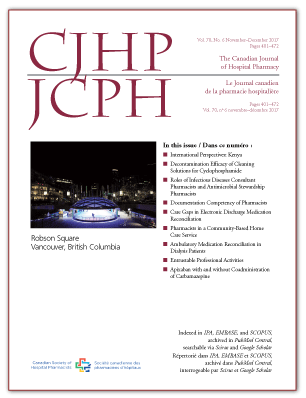Ambulatory Medication Reconciliation in Dialysis Patients: Benefits and Community Practitioners’ Perspectives
DOI:
https://doi.org/10.4212/cjhp.v70i6.1719Keywords:
medication reconciliation, hemodialysis, adverse drug events, medication discrepancies, survey, medication safety, bilan comparatif des medicaments, hémodialyse, événements indésirables liés aux médicaments, divergences concernant les medicaments, sondagAbstract
ABSTRACT
Background: Ambulatory medication reconciliation can reduce the frequency of medication discrepancies and may also reduce adverse drug events. Patients receiving dialysis are at high risk for medication discrepancies because they typically have multiple comorbid conditions, are taking many medications, and are receiving care from many practitioners. Little is known about the potential benefits of ambulatory medication reconciliation for these patients.
Objectives: To determine the number, type, and potential level of harm associated with medication discrepancies identified through ambulatory medication reconciliation and to ascertain the views of community pharmacists and family physicians about this service.
Methods: This retrospective cohort study involved patients initiating hemodialysis who received ambulatory medication reconciliation in a hospital renal program over the period July 2014 to July 2016. Discrepanciesidentified on the medication reconciliation forms for study patients were extracted and categorized by discrepancy type and potential level of harm. The level of harm was determined independently by a pharmacist and a nurse practitioner using a defined scoring system. In the event of disagreement, a nephrologist determined the final score. Surveys were sent to 52 community pharmacists and 44 family physicians involved in the care of study patients to collect their opinions and perspectives on ambulatory medication reconciliation.
Results: Ambulatory medication reconciliation was conducted 296 times for a total of 147 hemodialysis patients. The mean number of discrepancies identified per patient was 1.31 (standard deviation 2.00). Overall, 30% of these discrepancies were deemed to have the potential to cause moderate to severe patient discomfort or clinical deterioration. Survey results indicated that community practitioners found ambulatory medication reconciliation valuable for providing quality care to dialysis patients.
Conclusions: This study has provided evidence that ambulatory medication reconciliation can increase patient safety and potentially prevent adverse events associated with medication discrepancies.
RÉSUMÉ
Contexte : Le bilan comparatif des médicaments en soins ambulatoires peut réduire les divergences au chapitre des médicaments et les événements indésirables liés aux médicaments. Les divergences relatives aux médicaments représentent un risque élevé pour les patients dialysés, car ils souffrent normalement de multiples troubles comorbides, ils prennent souvent de nombreux médicaments et ils sont soignés par bon nombre de praticiens. Peu d’information existe sur les possibles avantages du bilan comparatif des médicaments en soins ambulatoires pour ces patients.
Objectifs : Déterminer le nombre et la catégorie des divergences concernant les médicaments constatées lors d’un bilan comparatif des médicaments en soins ambulatoires ainsi que la gravité potentielle des préjudices consécutifs. De plus, établir la position des pharmaciens communautaires et des médecins de famille sur cette modalité du bilan comparatif des médicaments.
Méthodes : La présente étude de cohorte rétrospective a été menée auprès de patients amorçant un traitement par hémodialyse pour qui un bilan comparatif des médicaments en soins ambulatoires a été réalisé dans le cadre d’un programme hospitalier des maladies du rein, entre juillet 2014 et juillet 2016. Les divergences trouvées dans les formulaires de bilan comparatif des médicaments ont été classées par catégorie et selon la gravité potentielle des préjudices. Le niveau du préjudice a été déterminé de manière indépendante par un pharmacien et un membre du personnel infirmier praticien à l’aide d’un système de notation défini. En cas de désaccord, le score final était établi par un néphrologue. Des sondages ont été envoyés à 52 pharmaciens communautaires et à 44 médecins de famille prodiguant des soins aux participants afin qu’ils expriment leurs opinions et leurs points de vue sur le bilan comparatif des médicaments en soins ambulatoires.
Résultats : En tout, 296 bilans comparatifs des médicaments en soins ambulatoires ont été effectués auprès de 147 patients hémodialysés. Le nombre moyen de divergences constatées par patient était de 1,31 (écart-type de 2,00). Dans l’ensemble, 30 % de ces divergences ont été considérées comme une source potentielle d’un inconfort allant de modéré à grave ou de dégradation clinique. Selon les résultats du sondage, les praticiens communautaires ont jugé le bilan comparatif des médicaments en soins ambulatoires utile à la prestation de soins de qualité aux patients dialysés.
Conclusions : D’après les résultats de l’étude, le bilan comparatif des médicaments en soins ambulatoires augmenterait la sécurité des patients et pourrait prévenir les événements indésirables liés aux divergences relatives aux médicaments.
Downloads
Published
Issue
Section
License
Copyright © Canadian Society of Healthcare-Systems Pharmacy.
After publication of a manuscript in the CJHP, the authors of the manuscript must obtain written permission from the CSHP (publications@cshp.ca) before reproducing any text, figures, tables, or illustrations from the work in future works of their own. If a submitted manuscript is declined for publication in the CJHP, all said rights shall revert to the authors. Please note that any forms (e.g., preprinted orders and patient intake forms) used by a specific hospital or other health care facility and included as illustrative material with a manuscript are exempt from this copyright transfer. The CJHP will require a letter from the hospital or health care facility granting permission to publish the document(s).










